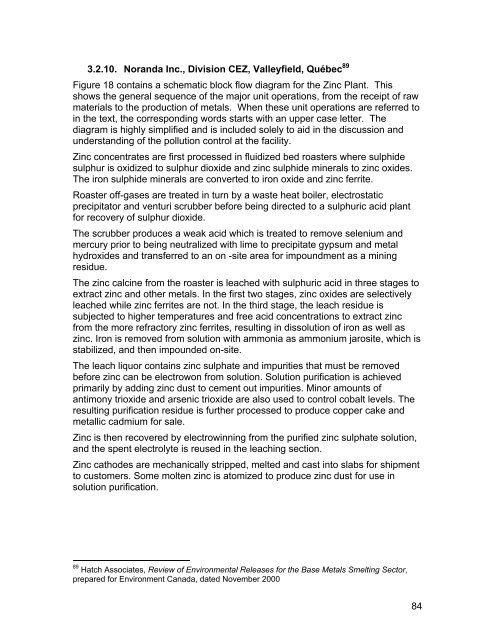(MERAF) for the Base Metals Smelting Sector - CCME
(MERAF) for the Base Metals Smelting Sector - CCME
(MERAF) for the Base Metals Smelting Sector - CCME
Create successful ePaper yourself
Turn your PDF publications into a flip-book with our unique Google optimized e-Paper software.
3.2.10. Noranda Inc., Division CEZ, Valleyfield, Québec 89<br />
Figure 18 contains a schematic block flow diagram <strong>for</strong> <strong>the</strong> Zinc Plant. This<br />
shows <strong>the</strong> general sequence of <strong>the</strong> major unit operations, from <strong>the</strong> receipt of raw<br />
materials to <strong>the</strong> production of metals. When <strong>the</strong>se unit operations are referred to<br />
in <strong>the</strong> text, <strong>the</strong> corresponding words starts with an upper case letter. The<br />
diagram is highly simplified and is included solely to aid in <strong>the</strong> discussion and<br />
understanding of <strong>the</strong> pollution control at <strong>the</strong> facility.<br />
Zinc concentrates are first processed in fluidized bed roasters where sulphide<br />
sulphur is oxidized to sulphur dioxide and zinc sulphide minerals to zinc oxides.<br />
The iron sulphide minerals are converted to iron oxide and zinc ferrite.<br />
Roaster off-gases are treated in turn by a waste heat boiler, electrostatic<br />
precipitator and venturi scrubber be<strong>for</strong>e being directed to a sulphuric acid plant<br />
<strong>for</strong> recovery of sulphur dioxide.<br />
The scrubber produces a weak acid which is treated to remove selenium and<br />
mercury prior to being neutralized with lime to precipitate gypsum and metal<br />
hydroxides and transferred to an on -site area <strong>for</strong> impoundment as a mining<br />
residue.<br />
The zinc calcine from <strong>the</strong> roaster is leached with sulphuric acid in three stages to<br />
extract zinc and o<strong>the</strong>r metals. In <strong>the</strong> first two stages, zinc oxides are selectively<br />
leached while zinc ferrites are not. In <strong>the</strong> third stage, <strong>the</strong> leach residue is<br />
subjected to higher temperatures and free acid concentrations to extract zinc<br />
from <strong>the</strong> more refractory zinc ferrites, resulting in dissolution of iron as well as<br />
zinc. Iron is removed from solution with ammonia as ammonium jarosite, which is<br />
stabilized, and <strong>the</strong>n impounded on-site.<br />
The leach liquor contains zinc sulphate and impurities that must be removed<br />
be<strong>for</strong>e zinc can be electrowon from solution. Solution purification is achieved<br />
primarily by adding zinc dust to cement out impurities. Minor amounts of<br />
antimony trioxide and arsenic trioxide are also used to control cobalt levels. The<br />
resulting purification residue is fur<strong>the</strong>r processed to produce copper cake and<br />
metallic cadmium <strong>for</strong> sale.<br />
Zinc is <strong>the</strong>n recovered by electrowinning from <strong>the</strong> purified zinc sulphate solution,<br />
and <strong>the</strong> spent electrolyte is reused in <strong>the</strong> leaching section.<br />
Zinc cathodes are mechanically stripped, melted and cast into slabs <strong>for</strong> shipment<br />
to customers. Some molten zinc is atomized to produce zinc dust <strong>for</strong> use in<br />
solution purification.<br />
89 Hatch Associates, Review of Environmental Releases <strong>for</strong> <strong>the</strong> <strong>Base</strong> <strong>Metals</strong> <strong>Smelting</strong> <strong>Sector</strong>,<br />
prepared <strong>for</strong> Environment Canada, dated November 2000<br />
84
















